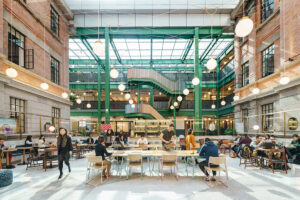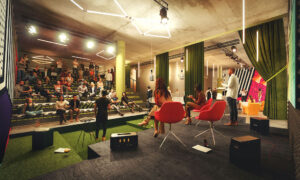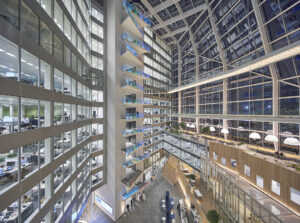As work evolves, it’s crucial to understand the new paradigms shaping our workplaces. Welcome back to our Unworking Weekly mini-series, inspired by new book “Unworking: The Reinvention of the Modern Office” by Philip Ross & Jeremy Myerson.
Over the past five weeks, we have explored the themes of each chapter, offering insights into the book’s vision for the future of work and the workplace. Offices have been integral to society for the past century, influencing everything from city architecture to daily routines. However, the pandemic triggered a re-evaluation of the office’s role, promoting a shift away from outdated practices. As we enter the sixth week of our series, we delve into Chapter 6, continuing our journey through the evolving landscape of work.
This week’s blog focuses on Chapter 6: Urbanism. Here, we examine the interplay between urban development and workplace transformation, shedding light on how changing urban landscapes are reshaping where and how we work.
Urbanism, in the context of work and workplace, refers to the design, organisation, and functionality of urban spaces to support modern work practices. It involves integrating work environments within the fabric of the city, promoting accessibility, sustainability, and community engagement.
The Rise of Flexible Urban Spaces
Urbanism in the modern workplace context emphasises the creation of flexible, adaptive spaces within cities that cater to the needs of a dynamic workforce. This flexibility includes coworking spaces, which offer freelancers, remote workers, and corporate teams access to high-quality office amenities without the long-term commitment of traditional leases, fostering collaboration and innovation.
Mixed-use developments integrate residential, commercial, and recreational spaces into cohesive environments, creating vibrant communities where people can live, work, and play with reduced commutes and increased convenience. Public areas are also being reimagined to support work-related activities, with parks, plazas, and cafes providing informal yet effective spaces for meetings, remote work, and networking. This blend of spaces contributes to a more sustainable, efficient, and engaging urban environment, reflecting the evolving needs and preferences of the modern workforce.
The WeWork Weihai Road in Shanghai is an excellent example of flexible urban space. Located in a historic building, this coworking space combines traditional architectural elements with modern amenities. It offers a variety of workspaces, including private offices, hot desks, and communal areas, all designed to foster collaboration and creativity. The integration of flexible spaces within a vibrant urban setting makes it a hub for professionals from various industries.

Community and Networking in Urban Workplaces
Urban workplaces are being increasingly recognised not just for their functional roles in productivity but also as vital hubs for social interaction and networking. In today’s urban landscape, workplaces are designed not only to accommodate tasks and projects but also to foster environments where collaboration, creativity, and relationships thrive. This evolution is driven by a deeper understanding of the human need for connection and community, which plays a crucial role in employee satisfaction, retention, and overall organisational success.
An example of an urban workplace that emphasises community and networking is Huckletree West in London. Located in White City, Huckletree West is a coworking space designed specifically to foster creativity, collaboration, and community engagement among its members.
Huckletree West stands out for its vibrant workspace, which combines modern design with elements that encourage interaction. One of its key strengths lies in its community-focused initiatives and events. The workspace hosts regular networking events, workshops, and industry-specific meetups that enable members to connect, share knowledge, and collaborate on projects. These events not only enhance professional networking opportunities but also contribute to a supportive and inclusive community culture.

Sustainability and Smart Urban Design
Sustainable urbanism focuses on creating environmentally friendly and energy-efficient workspaces that reduce the carbon footprint of urban areas. This includes incorporating green building practices, optimising energy use, and designing urban workspaces that promote sustainable living.
The Edge in Amsterdam is a prime example of sustainable urban design. Known as the “smartest” and greenest building in the world, The Edge uses advanced technology to optimise energy efficiency and reduce waste. It features solar panels, a rainwater harvesting system, and a smart lighting system that adjusts based on occupancy and natural light levels. The building’s design not only minimises environmental impact but also provides a healthy and productive work environment.

The discussion in Chapter 6 of Unworking highlights the evolving relationship between urbanism and the workplace. As cities continue to grow and change, the integration of flexible spaces, community-focused designs, and sustainable practices becomes increasingly important. These themes underscore the need for workplaces to adapt to the dynamic nature of urban life, fostering environments that support both productivity and well-being.
Readers can dive deeper into the exploration of urbanism and its impact on the future of work in Philip Ross and Jeremy Myerson’s latest book, Unworking: The Reinvention of the Modern Office. By understanding the principles of modern urbanism, we can create dynamic, sustainable, and community-oriented work environments that align with the evolving needs of the workforce.
Grab your copy of Unworking from Amazon here.
